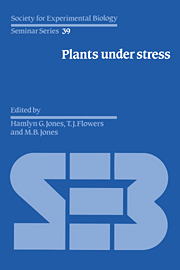Book contents
- Frontmatter
- Contents
- Contributors
- Preface
- 1 Introduction: some terminology and common mechanisms
- 2 The impact of environmental stresses on ecosystems
- 3 Whole-plant responses to stress in natural and agricultural systems
- 4 Photosynthesis and gas exchange
- 5 Regulation of growth and development of plants growing with a restricted supply of water
- 6 Stresses, membranes and cell walls
- 7 Desiccation injury, anhydrobiosis and survival
- 8 Molecular biology: application to studies of stress tolerance
- 9 Environmental control of gene expression and stress proteins in plants
- 10 Plant tissue and protoplast culture: applications to stress physiology and biochemistry
- 11 Breeding methods for drought resistance
- 12 Selection for physiological characters – examples from breeding for salt tolerance
- 13 Prospects for improving crop production in stressful environments
- Index
4 - Photosynthesis and gas exchange
Published online by Cambridge University Press: 16 March 2010
- Frontmatter
- Contents
- Contributors
- Preface
- 1 Introduction: some terminology and common mechanisms
- 2 The impact of environmental stresses on ecosystems
- 3 Whole-plant responses to stress in natural and agricultural systems
- 4 Photosynthesis and gas exchange
- 5 Regulation of growth and development of plants growing with a restricted supply of water
- 6 Stresses, membranes and cell walls
- 7 Desiccation injury, anhydrobiosis and survival
- 8 Molecular biology: application to studies of stress tolerance
- 9 Environmental control of gene expression and stress proteins in plants
- 10 Plant tissue and protoplast culture: applications to stress physiology and biochemistry
- 11 Breeding methods for drought resistance
- 12 Selection for physiological characters – examples from breeding for salt tolerance
- 13 Prospects for improving crop production in stressful environments
- Index
Summary
Introduction
Photosynthesis and gas exchange of leaves are affected by many stresses including drought, flooding, salinity, chilling, high temperature, soil compaction and inadequate nutrition. Many, but not all, of these stresses have symptoms in common. For example, stomatal conductance and the rate of assimilation of CO2 per unit leaf area often decrease when stress occurs. Further, it is possible that several of the stresses may exert their effects, in part, by increasing the levels of the hormone abscisic acid (ABA) in the leaf epidermis. This hormone is known to close stomata when applied to leaves.
There have been many studies of the effects of stress on gas exchange. Some have involved leaves that were fully expanded and some have been on leaves that were still expanding. Sometimes the stresses have been chronic, and sometimes they have been imposed for short periods. Sometimes the stresses have been severe, and sometimes they have been mild. Often they have been imposed more rapidly than occurs naturally.
It is thus easy to understand why interpretations have also been varied. There needs to be a more systematic approach in our studies, paying more attention to genetic differences that exist and including observations of what happens when stress is released. More teamwork may be needed to apply the range of techniques now at hand.
In this chapter we review recent developments, concentrating mostly on the effects of water stress because of its great importance, but trying where possible to identify general problems. As noted above, accumulation of ABA in leaves is common under stress, and we review its effects on gas exchange.
- Type
- Chapter
- Information
- Plants under StressBiochemistry, Physiology and Ecology and their Application to Plant Improvement, pp. 47 - 70Publisher: Cambridge University PressPrint publication year: 1989
- 45
- Cited by



